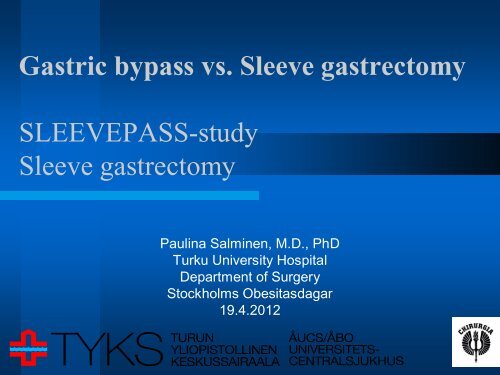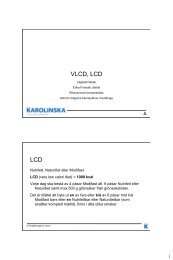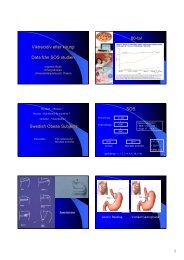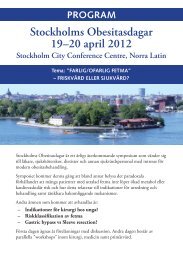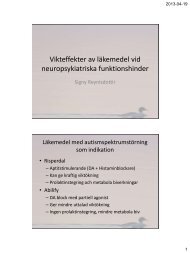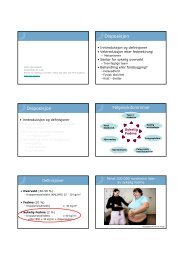SLEEVEPASS: A randomized prospective study ... - Obesitasdagar
SLEEVEPASS: A randomized prospective study ... - Obesitasdagar
SLEEVEPASS: A randomized prospective study ... - Obesitasdagar
Create successful ePaper yourself
Turn your PDF publications into a flip-book with our unique Google optimized e-Paper software.
Gastric bypass vs. Sleeve gastrectomy<br />
<strong>SLEEVEPASS</strong>-<strong>study</strong><br />
Sleeve gastrectomy<br />
Paulina Salminen, M.D., PhD<br />
Turku University Hospital<br />
Department of Surgery<br />
Stockholms <strong>Obesitasdagar</strong><br />
19.4.2012
Swedish<br />
Obese<br />
Subjects<br />
SOS<br />
Percent weight change over 15 years<br />
Weight change, %<br />
0<br />
-10<br />
-20<br />
Control<br />
Banding<br />
VBG<br />
-30<br />
Gastric<br />
bypass<br />
0 1 2 3 4 6 8 10 15<br />
Years of follow up<br />
Sjöström L et al. N Engl J Med 2007; 357: 741-52.
Bariatric surgery in Finland 2006 - 2012<br />
• 2006: 99 operations<br />
• 2007: 154 operations<br />
• 2008: 430 operations<br />
– RYGB 270, SG 150, LGB < 10<br />
• 2009: 666 operations<br />
– RYGB 472, SG 187, LGB 7<br />
• 2010: 769 operations<br />
• 2011: 1056 operations<br />
– RYGB 919, SG 134, LGB 2, DS 1<br />
• 2010 registered association<br />
– FOTEG (Finnish(<br />
Obesity Treatment Expert Group)<br />
– www.foteg.fi
Long-term PROS for sleeve<br />
gastrectomy<br />
• NO internal hernias<br />
NO bowel<br />
obstruction<br />
• NO malabsorption<br />
• NO excluded<br />
segments<br />
• An intact gi-tract
<strong>SLEEVEPASS</strong> <strong>study</strong>group<br />
• Turku University<br />
Hospital<br />
– Paulina Salminen, Mika<br />
Helmiö, Jari Ovaska<br />
• Vaasa Central Hospital<br />
– Pipsa Peromaa, Mikael<br />
Victorzon<br />
• Peijas Hospital, Helsinki<br />
– Anne Juuti, Marja<br />
Leivonen
Study hypothesis<br />
• “As sleeve gastrectomy is less traumatic,<br />
easier and faster to perform compared<br />
with gastric bypass, LSG could become<br />
the procedure of choice to treat morbid<br />
obesity if the long-term results of weight<br />
loss and resolution of comorbidities are<br />
comparable with laparoscopic gastric<br />
bypass.”<br />
• www.clinicaltrials.gov NCT 00793143<br />
• Patient enrollment and operative treatment<br />
April 2008 – June 2010
Inclusion criteria<br />
• BMI 40 or BMI 35 and a<br />
significant co-morbidity associated<br />
with morbid obesity<br />
• Age 18 – 60 years<br />
• Previous successfully instituted and<br />
supervised but failed adequate diet<br />
and exercise program
Exclusion criteria<br />
• BMI > 60<br />
• Age > 60 or < 18<br />
• Significant psychiatric disorder<br />
• Severe eating disorder<br />
• Active alcohol / substance abuse<br />
• Active gastric ulcer disease<br />
• Difficult GERD with a large hiatal hernia<br />
• Previous bariatric surgery
Preoperative evaluation<br />
• Multidisciplinary evaluation<br />
• Upper gastrointestinal endoscopy<br />
– Small hiatal hernia: SLEEVE 19.8 %, BYPASS<br />
21.8 %<br />
– Helicobacter pylori: SLEEVE 18.6 %, BYPASS<br />
17.1 %<br />
• Ultrasound examination<br />
– Gallstones: SLEEVE 22.9 %, BYPASS 25.3 %
Operative technique / RYGB<br />
• A small gastric pouch (20 – 40<br />
ml)<br />
• Biliopancreatic limb 50 – 80 cm<br />
• Antecolic gastrojejunostomy<br />
– Linear (45 mm) n = 56<br />
– Circular (OrVil 25 mm) n = 59<br />
• Alimentary limb 150 cm<br />
• Jejunojejunostomy<br />
– Closure: running suture /<br />
totally stapled technique<br />
• NO routine closure of<br />
mesenteric defects<br />
• Methylene blue test for<br />
gastrojejunostomy
Operative technique / SG<br />
• Calibration bougie 33 –<br />
35 Fr<br />
• 1st resection 4 – 6 cm<br />
proximal to the pylorus<br />
• 2 x green-load firings, ~<br />
4 x blue-load firings<br />
• Resection followed by<br />
mobilization of the<br />
stomach<br />
• Methylene blue test 2/3<br />
centers
• Patient demographics (p = ns)<br />
– Age: median 49 years (range 23 – 67<br />
years)<br />
– 70 % , 30 % <br />
– Preoperative BMI: median 44.6 kg/m²<br />
(range 35 – 66 kg/m²)
<strong>SLEEVEPASS</strong> CONSORT 30-day<br />
flowchart
<strong>SLEEVEPASS</strong>: Operation time and<br />
hospitalization<br />
SLEEVE BYPASS p-value<br />
Mean operation<br />
time (min)<br />
66 min<br />
(40 – 188 min)<br />
94 min<br />
(52 – 195 min)<br />
<strong>SLEEVEPASS</strong>: Complications SG vs.<br />
RYGB – 30-day morbidity<br />
• Minor<br />
– = all other postoperative complications<br />
– SG 7.4 % vs. RYGB 17.1. % (p = 0.023)<br />
• Major<br />
– = reoperation, hospital stay > 7 days, need for blood transfusions > 4<br />
units<br />
– SG 5.8 % vs. RYGB 9.4 % (p = 0.292)
<strong>SLEEVEPASS</strong>: Complications SG vs.<br />
RYGB – 30-day morbidity<br />
• Minor<br />
– = all other postoperative complications<br />
– SG 7.4 % vs. RYGB 17.1. % (p = 0.023)<br />
• Major<br />
– = reoperation, hospital stay > 7 days, need for blood transfusions > 4<br />
units<br />
– SG 5.8 % vs. RYGB 9.4 % (p = 0.292)
<strong>SLEEVEPASS</strong>: Complications SG vs.<br />
RYGB – 30-day morbidity<br />
• Mortality 0 %<br />
• Overall morbidity<br />
– SG 16.2 % vs RYGB 26.5 % (p = 0.010)
<strong>SLEEVEPASS</strong> SG Reoperations, p = ns<br />
SLEEVE<br />
• Five reoperations (4.1 %) on three patients<br />
• Patient 1<br />
– Arterial bleeding laparotomy on the operation<br />
day<br />
• Patient 2<br />
– Bleeding re-laparoscopy on the 1st postop.<br />
day<br />
• Patient 3<br />
– Bleeding re-laparoscopy on the 1st postop.<br />
day<br />
– Small bowel perforation re-laparoscopy at two<br />
weeks laparotomy + bowel resection
<strong>SLEEVEPASS</strong> RYGB Reoperations<br />
BYPASS<br />
• Six reoperations (5.1 %) on four patients<br />
• Patient 1<br />
– Bleeding re-laparoscopy on the operation day<br />
• Patient 2<br />
– Bleeding re-laparoscopy on the 1st postop. day<br />
• Patient 3<br />
– Torsion of the enteroanastomosis laparotomy on<br />
the 5th postop. day<br />
• Patient 4<br />
– Bleeding re-laparoscopy on the 7th postop. day <br />
laparotomy on the 14th postop. day angiography<br />
and coiling of the pseudoaneurysm on the 17th<br />
postop.day
• 123 papers, 12 129 patients
• 12 months mean EWL<br />
– SG 56 % vs. RYGB<br />
68 % (p < 0.01)<br />
– 17 SG studies, 12<br />
RYGB studies<br />
• 24 months mean EWL<br />
– SG 61 % vs. RYGB<br />
70 % (p = 0.09)<br />
– 7 SG studies, 10<br />
RYGB studies
• 5-year follow-up:64 patients / 12 129 patients (0,5 %)
• 11/2001 – 8 / 2002, n = 53<br />
• 6-year follow-up stand-alone SG<br />
– 30 / 41 patients, telephone<br />
questionnaire<br />
– EWL 53 % vs. 78 % at 3-year<br />
follow-up<br />
– New GERD complaints in 21 %<br />
• 11 patients underwent DS<br />
– EWL 57 % vs. 73 % at 3-year<br />
follow-up<br />
Ann Surg 2010;252: 319-324
• 34-Fr bougie ”to guide the gastric division” vs.<br />
to calibrate a more narrow sleeve?<br />
• Follow-up visits?<br />
• Post-SG GERD?
• Group A: no calibration<br />
• Group B: 44 Fr<br />
• Group C: 32 Fr<br />
• B & C (!) higher %EWL
• n = 26<br />
• 5-year mean EWL 55 %<br />
• 15 % converted to RYGB<br />
– Weight loss failure n = 3<br />
– Severe reflux n = 1<br />
• 31 % (n = 8) required daily PPI
• Mean preoperative BMI 39.3 kg/m²<br />
• At median follow-up of ~ 4 years mean<br />
EWL 72.3 % (n = 83 / 102 patients) vs. EWL<br />
55.9 % at 6-year follow-up (23 patients)
• Mean preoperative<br />
BMI 36.9 kg/m²,<br />
mean age 37 years<br />
• n = 773 <br />
• EWL at 3-year<br />
follow-up 84.5 %<br />
• Leakage rate 0.7 %<br />
• Stenosis 0.1 %<br />
• GERD 0.7 %
• Collective experience of > 12 000 SG<br />
• Achieving consensus 70 % agreement<br />
• No consensus < 70 % agreement
SG technique consensus<br />
Rosenthal et al. Soard 2012;8: 8-19<br />
• Bougie!<br />
• Antrum / green loads<br />
• Transsection 2 – 6 cm from pylorus<br />
• Last firing AWAY from the GE junction!<br />
• Complete mobilization of the fundus<br />
• The use of staple line reinforcement
SG and GERD<br />
Rosenthal et al. Soard 2012;8: 8-19<br />
• Preoperative<br />
evaluation<br />
• Hiatoplasty and SG?
RYGB vs. SG: Weight regain?<br />
SOS<br />
Percent weight change over 15 years<br />
Weight change, %<br />
0<br />
-10<br />
-20<br />
Control<br />
Banding<br />
VBG<br />
-30<br />
Gastric<br />
bypass<br />
0 1 2 3 4 6 8 10 15<br />
Years of follow up<br />
Sjöström L et al. N Engl J Med 2007; 357: 741-52. Himpens et al. Ann Surg 2010;252:319-324
In conclusion SG 2012<br />
• SG a valid stand-alone<br />
procedure<br />
• Technical aspects<br />
• Long-term follow-up is<br />
required<br />
• Patient selection<br />
• GERD? (postoperative<br />
incidence 0.7 % – 31 %)
In conclusion RCT: <strong>SLEEVEPASS</strong><br />
• At 30-day analysis SG is associated with a<br />
shorter operation time and fewer early<br />
complications<br />
• At 6-month follow-up SG and RYGB have<br />
similar %EWL, resolution of co-morbidities<br />
and morbidity rate<br />
• Long-term follow-up is required to<br />
determine the effect of sleeve gastrectomy<br />
on weight loss and resolution of obesity<br />
related co-morbidities compared with RYGB<br />
• <strong>SLEEVEPASS</strong>-trial follow-up will be<br />
continued up to 15 years
Thank You!


